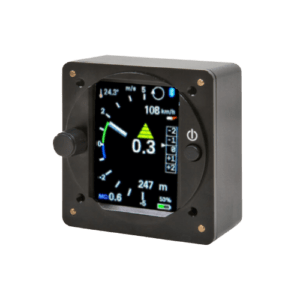About the Variometer
Overview
The new XC-Vario is a fully-fledged stand-alone variometer with a modern sunlight-readable display and a built-in loudspeaker. It sends the data from all sensors (altitude, vario, speed and temperature) and, if necessary, FLARM via Bluetooth, WiFi or serially in various formats (e.g. OpenVario, Borgelt, Cambridge 302) to the XCSoar crosscountry flight navigation software. A separate driver for the XCVario has been developed, included in the XCSoar project, and is available since 2021. The 2022 series has a second serial interface for optimal connection to OpenVario, increased power of the audio amplifier (2 watts), and a direction and position sensor (AHRS) which is offered as an additional option. A CAN bus interface has been added for Twin to connect a second vario on the rear seat for twin seaters and more. The position sensor supplements the load factor in the calculation model for a precise target seam or stall warning under accelerated conditions, and also supplies the data to XCSoar for the horizon display.
With the sensors, special care was taken to filter the data, a forward-thinking Kalman filter stabilises the vario display optimally without the usual delay of a few seconds that conventional low-pass filters bring with them.
The display of the information on the XCVario can be configured, in addition to 
 the previous “Airliner” style, the “Retro” style, can also be selected with the latest software. The new style implements a conventional and easily readable pointer display implemented on request, which most pilots know and are used to from the mechanical round instruments. Here, too, the display area can be configured, as well as the units for vario, altitude and speed according to international standards such as knots, feet, flight level and more.
the previous “Airliner” style, the “Retro” style, can also be selected with the latest software. The new style implements a conventional and easily readable pointer display implemented on request, which most pilots know and are used to from the mechanical round instruments. Here, too, the display area can be configured, as well as the units for vario, altitude and speed according to international standards such as knots, feet, flight level and more.
No further special OpenVario hardware is necessary, XCSoar, LK8000, TopHat and more runs on any XCSoarAndroid device. Most Android devices already have an internal GPS. Alternatively, the GPS data for XCSoar can also be obtained via FLARM or our GPS antenna that can be connected to the device in case there no GPS source on board. This setup allows a full ‘OpenVario’ with a moving map, a full route and an accurate final approach computer. Wind calculation as well as speed-to-fly and many other features and functions would not be possible without this data. Changing the MacCready value, ballast, or QNH on the XCVario will update the value on XCSoar and vice versa. The new developed XCTouch Series were made for a perfect combination with the XCVario, allows panel mount or Ram mount inside the cockpit, and works perfect even in hot or cold environment with 12V on board power supply with low power demands and bright 1000 nits sunlight readable displays.
In connection with FLARM, XC-Soar offers valuable information on traffic such as distance, altitude difference and climb rates of the other aircraft with FLARM installed. Of course, touchscreen devices can be used for easy operation of XCSoar. Elaborate and complicated stick remote controls are no longer necessary.
Software
The software for this is available on the open source platform GitHub over a period of several years and now has many features and a high level of stability. The same applies to XCSoar, which has matured for many years with thousands of installations on a wide variety of hardware and is very stable. For technical details on software and hardware as well as their evolution, please check our GitHub.
Hardware
The device comes in an elegant, satin black anodized aluminum housing. When selecting the electronic components, the focus was consistently on good quality with a long life expectancy. We do not use short-lived electrolytic capacitors or batteries with a limited life expectancy in the rough temperature range of a cockpit. The electronics are manufactured in one of the largest factories in the world, fully automated in series of three-digit numbers. The development, integration and quality tests of the variometers take place in Germany and the Netherlands, and have been tested in the air on long flights of over 850 km. The new hardware can be accommodated in almost any instrument panel like any 57mm standard instrument and is offered at a low price. For two-seaters, the same inexpensive hardware can be used as in the two-seater mode, wirelessly connected via Wifi on the second seat. Cabling or tubing on the second place is therefore not necessary. This means that all functions on the second variometer are available without restriction as on the front seat. End of Q2 in 2023, there will be an 80mm type of the vario available, directly fitting into an 80mm panel cutout.
The hardware is fully programmed with the software and can be adapted to any aircraft polar on request, a growing library with more than 100 polars is pre-installed on the variometer and can be selected in the setup.
